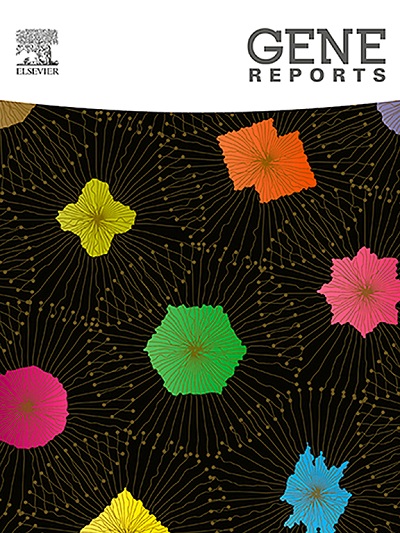Association between ABO (H) secretory status and rheumatoid arthritis
IF 1
Q4 GENETICS & HEREDITY
引用次数: 0
Abstract
Introduction
ABH antigens are present on the surface of blood cells and in body secretions such as saliva. Our study aimed to investigate the frequency distribution of secretor and non-secretor phenotypes among patients with rheumatoid arthritis. The lack of blood group antigens in body secretions increases the incidence of certain diseases, including autoimmune diseases and infections.
Methods
This case-control study was conducted on 250 patients referred to Allameh Bohloul Gonabadi Hospital. 120 patients had rheumatoid arthritis and 130 controls without rheumatoid arthritis. 2 mL of saliva was collected from the patients non-invasively. We determined the secretory and non-secretory status of the patients by examining agglutination or non-agglutination by visual and microscopic methods.
Results
Secretory status in the case group, 75 out of 120 patients (62.5 %) were secretory and 45 (37.5 %) were non-secretory. In the control group, 120 out of 130 patients (92.3 %) were secretory and 10 (7.7 %) were non-secretory. Non-secretors were significantly more associated with rheumatoid arthritis (P < 0.05).
Conclusions
The non-secretory of ABH substances may be associated with rheumatoid arthritis and these results were found more in women than in men, Although, to investigate whether the increased frequency of with rheumatoid arthritis among non-secretors is coincidental or indeed genetic, a prospective cohort study of non-secretors in relation to with rheumatoid arthritis is required.

ABO (H)分泌状态与类风湿关节炎的关系
abh抗原存在于血细胞表面和唾液等身体分泌物中。本研究旨在探讨类风湿性关节炎患者分泌型和非分泌型表型的频率分布。身体分泌物中缺乏血型抗原会增加某些疾病的发病率,包括自身免疫性疾病和感染。方法对250例转诊至Allameh Bohloul Gonabadi医院的患者进行病例对照研究,其中120例有类风湿关节炎,130例无类风湿关节炎。无创采集患者唾液2ml。我们通过视觉和显微镜检查凝集或不凝集来确定患者的分泌和非分泌状态。结果120例患者中有75例(62.5%)有分泌,45例(37.5%)无分泌。对照组130例患者中120例(92.3%)为分泌型,10例(7.7%)为非分泌型。无分泌物者与类风湿关节炎的相关性显著增高(P <;0.05)。结论:不分泌ABH物质可能与类风湿关节炎有关,女性比男性更多。然而,为了调查类风湿关节炎发病率增加是巧合还是遗传,还需要对类风湿关节炎与非分泌物质的关系进行前瞻性队列研究。
本文章由计算机程序翻译,如有差异,请以英文原文为准。
求助全文
约1分钟内获得全文
求助全文
来源期刊

Gene Reports
Biochemistry, Genetics and Molecular Biology-Genetics
CiteScore
3.30
自引率
7.70%
发文量
246
审稿时长
49 days
期刊介绍:
Gene Reports publishes papers that focus on the regulation, expression, function and evolution of genes in all biological contexts, including all prokaryotic and eukaryotic organisms, as well as viruses. Gene Reports strives to be a very diverse journal and topics in all fields will be considered for publication. Although not limited to the following, some general topics include: DNA Organization, Replication & Evolution -Focus on genomic DNA (chromosomal organization, comparative genomics, DNA replication, DNA repair, mobile DNA, mitochondrial DNA, chloroplast DNA). Expression & Function - Focus on functional RNAs (microRNAs, tRNAs, rRNAs, mRNA splicing, alternative polyadenylation) Regulation - Focus on processes that mediate gene-read out (epigenetics, chromatin, histone code, transcription, translation, protein degradation). Cell Signaling - Focus on mechanisms that control information flow into the nucleus to control gene expression (kinase and phosphatase pathways controlled by extra-cellular ligands, Wnt, Notch, TGFbeta/BMPs, FGFs, IGFs etc.) Profiling of gene expression and genetic variation - Focus on high throughput approaches (e.g., DeepSeq, ChIP-Seq, Affymetrix microarrays, proteomics) that define gene regulatory circuitry, molecular pathways and protein/protein networks. Genetics - Focus on development in model organisms (e.g., mouse, frog, fruit fly, worm), human genetic variation, population genetics, as well as agricultural and veterinary genetics. Molecular Pathology & Regenerative Medicine - Focus on the deregulation of molecular processes in human diseases and mechanisms supporting regeneration of tissues through pluripotent or multipotent stem cells.
 求助内容:
求助内容: 应助结果提醒方式:
应助结果提醒方式:


